India’s Got Talent (IGT) is one of the most popular reality talent shows in India, showcasing a wide array of talents from across the country. Season 1 premiered in 2009, introducing audiences to an extraordinary showcase of skills, stories, and backgrounds. The Season 1 winner, the Prince Dance Group, stunned the country and left an indelible mark on Indian entertainment. By winning the inaugural season, they not only captivated audiences but also reshaped the narrative of dance and performance art in India.
Here’s a look at how India’s Got Talent Season 1 winner changed the landscape of Indian entertainment and inspired a generation of artists.
1. Breaking Cultural and Regional Barriers
Prince Dance Group, from Berhampur, Odisha, emerged as a unique dance troupe with a compelling backstory. Led by T. Krishna Mohan Reddy, a physically challenged artist, the group included laborers and daily wage earners who shared a common passion for dance. The group’s win highlighted the power of dedication and artistic expression, transcending regional, social, and economic barriers.
Their story inspired Indians from all backgrounds, especially those from smaller towns and rural areas, proving that talent knows no geographic boundaries. Their success showed that people from all walks of life could achieve greatness, sparking a new wave of inclusivity in Indian reality television.
2. Redefining Dance in Indian Entertainment
Prince Dance Group redefined how dance was perceived in India. They introduced unique storytelling techniques through their performances, often focusing on cultural and mythological themes. Their winning performance, inspired by the tale of Lord Vishnu, combined classical Indian dance elements with innovative choreography, creating a visually stunning experience that resonated deeply with the audience.
Before their win, dance in Indian entertainment was largely limited to Bollywood-style choreography. Prince Dance Group showed that dance could be a powerful medium for storytelling, capable of blending tradition with innovation. This shift opened doors for a broader range of dance styles on mainstream platforms, inspiring other shows and performers to experiment with form and content.
3. Inspiring a New Generation of Reality Show Talent
Winning India’s Got Talent Season 1 wasn’t just a personal achievement for the group; it became a cultural moment that encouraged countless others to showcase their talent on similar platforms. The success of the Prince Dance Group paved the way for an increase in talent-based reality shows, where individuals and groups from every corner of India felt encouraged to display their skills.
Many of today’s performers on shows like Dance India Dance and Super Dancer cite IGT’s Season 1 as a pivotal moment that motivated them to pursue their dreams. Prince Dance Group’s victory helped people see that such platforms could lead to substantial careers and national recognition. It showed that these shows weren’t just about entertainment—they were life-changing opportunities.
4. Social Impact and the Power of Stories
One of the most significant contributions of India’s Got Talent Season 1 winner was their social impact. Prince Dance Group’s members came from humble backgrounds, many working as laborers or artisans. Their story of struggle and perseverance resonated with audiences, reminding them that talent often lies in unexpected places.
By winning, they brought attention to the hardships faced by underprivileged communities, highlighting the transformative power of the arts. Their success underscored the idea that one’s background does not define one’s potential. This narrative of overcoming obstacles inspired more talent shows to focus on contestants’ personal stories, making Indian reality TV more relatable and impactful.
5. Influencing the Popularity of Talent-Based Shows
India’s Got Talent Season 1 winner also contributed to the popularity of talent-based shows across India. Their success proved that Indian audiences were deeply interested in performances that showcased authentic talent and moving personal stories, rather than simply focusing on glamour. This led to a surge in talent-oriented reality shows across TV channels in India, encouraging diverse talents and formats that had not been widely recognized before.
Today, shows like India’s Best Dancer, Indian Idol, and India’s Got Talent itself continue to draw millions of viewers, who tune in to witness extraordinary talent from all corners of the nation. The Prince Dance Group’s success contributed significantly to this trend, demonstrating that audiences were eager to celebrate the talents of everyday people and authentic artistry.
6. Promoting Traditional Art Forms and Heritage
Through their performances, Prince Dance Group often showcased elements of Indian heritage, mythology, and classical dance forms. Their focus on traditional narratives and themes reminded audiences of the rich cultural heritage embedded in Indian arts. By doing so, they promoted an appreciation for India’s cultural roots in a modern entertainment format, striking a balance between innovation and tradition.
Their success also encouraged other performers to explore and integrate traditional Indian themes in their acts. Today, it’s common to see contestants on Indian talent shows incorporating local art forms, classical dance, and regional storytelling methods—thanks to the foundation laid by Prince Dance Group.
7. A Lasting Legacy
India’s Got Talent Season 1 winner, the Prince Dance Group, created a legacy that lives on in Indian entertainment. They demonstrated the potential of talent-based reality shows to be transformative for both contestants and audiences alike. Their influence can still be seen in the numerous dance groups and solo performers who continue to draw inspiration from their journey, using art as a tool for personal expression and social impact.
In conclusion, the victory of India’s Got Talent Season 1 winner was not just a win for the group—it was a victory for Indian entertainment, proving that talent is diverse, unique, and resilient. By inspiring artists and audiences across the nation, they opened doors for a new era of entertainment where authenticity, passion, and dedication are celebrated as much as skill.

